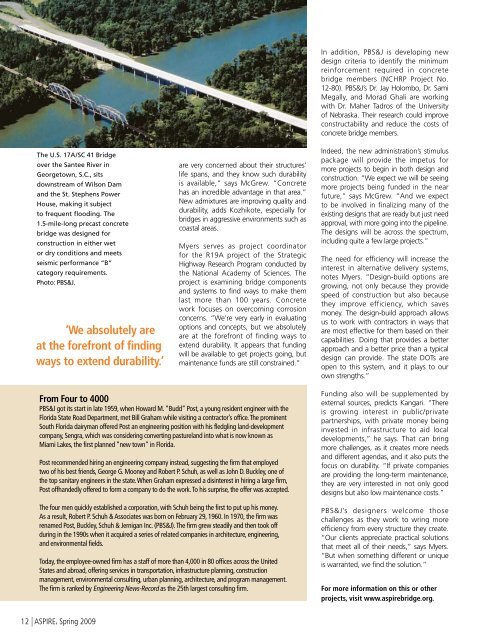ASPIRE Spring 09 - Aspire - The Concrete Bridge Magazine
ASPIRE Spring 09 - Aspire - The Concrete Bridge Magazine
ASPIRE Spring 09 - Aspire - The Concrete Bridge Magazine
You also want an ePaper? Increase the reach of your titles
YUMPU automatically turns print PDFs into web optimized ePapers that Google loves.
In addition, PBS&J is developing new<br />
design criteria to identify the minimum<br />
reinforcement required in concrete<br />
bridge members (NCHRP Project No.<br />
12-80). PBS&J’s Dr. Jay Holombo, Dr. Sami<br />
Megally, and Morad Ghali are working<br />
with Dr. Maher Tadros of the University<br />
of Nebraska. <strong>The</strong>ir research could improve<br />
constructability and reduce the costs of<br />
concrete bridge members.<br />
<strong>The</strong> U.S. 17A/SC 41 <strong>Bridge</strong><br />
over the Santee River in<br />
Georgetown, S.C., sits<br />
downstream of Wilson Dam<br />
and the St. Stephens Power<br />
House, making it subject<br />
to frequent flooding. <strong>The</strong><br />
1.5-mile-long precast concrete<br />
bridge was designed for<br />
construction in either wet<br />
or dry conditions and meets<br />
seismic performance “B”<br />
category requirements.<br />
Photo: PBS&J.<br />
‘We absolutely are<br />
at the forefront of finding<br />
ways to extend durability.’<br />
are very concerned about their structures’<br />
life spans, and they know such durability<br />
is available,” says McGrew. “<strong>Concrete</strong><br />
has an incredible advantage in that area.”<br />
New admixtures are improving quality and<br />
durability, adds Kozhikote, especially for<br />
bridges in aggressive environments such as<br />
coastal areas.<br />
Myers serves as project coordinator<br />
for the R19A project of the Strategic<br />
Highway Research Program conducted by<br />
the National Academy of Sciences. <strong>The</strong><br />
project is examining bridge components<br />
and systems to find ways to make them<br />
last more than 100 years. <strong>Concrete</strong><br />
work focuses on overcoming corrosion<br />
concerns. “We’re very early in evaluating<br />
options and concepts, but we absolutely<br />
are at the forefront of finding ways to<br />
extend durability. It appears that funding<br />
will be available to get projects going, but<br />
maintenance funds are still constrained.”<br />
Indeed, the new administration’s stimulus<br />
package will provide the impetus for<br />
more projects to begin in both design and<br />
construction. “We expect we will be seeing<br />
more projects being funded in the near<br />
future,” says McGrew. “And we expect<br />
to be involved in finalizing many of the<br />
existing designs that are ready but just need<br />
approval, with more going into the pipeline.<br />
<strong>The</strong> designs will be across the spectrum,<br />
including quite a few large projects.”<br />
<strong>The</strong> need for efficiency will increase the<br />
interest in alternative delivery systems,<br />
notes Myers. “Design-build options are<br />
growing, not only because they provide<br />
speed of construction but also because<br />
they improve efficiency, which saves<br />
money. <strong>The</strong> design-build approach allows<br />
us to work with contractors in ways that<br />
are most effective for them based on their<br />
capabilities. Doing that provides a better<br />
approach and a better price than a typical<br />
design can provide. <strong>The</strong> state DOTs are<br />
open to this system, and it plays to our<br />
own strengths.”<br />
From Four to 4000<br />
PBS&J got its start in late 1959, when Howard M. “Budd” Post, a young resident engineer with the<br />
Florida State Road Department, met Bill Graham while visiting a contractor’s office. <strong>The</strong> prominent<br />
South Florida dairyman offered Post an engineering position with his fledgling land-development<br />
company, Sengra, which was considering converting pastureland into what is now known as<br />
Miami Lakes, the first planned “new town” in Florida.<br />
Post recommended hiring an engineering company instead, suggesting the firm that employed<br />
two of his best friends, George G. Mooney and Robert P. Schuh, as well as John D. Buckley, one of<br />
the top sanitary engineers in the state. When Graham expressed a disinterest in hiring a large firm,<br />
Post offhandedly offered to form a company to do the work. To his surprise, the offer was accepted.<br />
<strong>The</strong> four men quickly established a corporation, with Schuh being the first to put up his money.<br />
As a result, Robert P. Schuh & Associates was born on February 29, 1960. In 1970, the firm was<br />
renamed Post, Buckley, Schuh & Jernigan Inc. (PBS&J). <strong>The</strong> firm grew steadily and then took off<br />
during in the 1990s when it acquired a series of related companies in architecture, engineering,<br />
and environmental fields.<br />
Today, the employee-owned firm has a staff of more than 4,000 in 80 offices across the United<br />
States and abroad, offering services in transportation, infrastructure planning, construction<br />
management, environmental consulting, urban planning, architecture, and program management.<br />
<strong>The</strong> firm is ranked by Engineering News-Record as the 25th largest consulting firm.<br />
Funding also will be supplemented by<br />
external sources, predicts Kangari. “<strong>The</strong>re<br />
is growing interest in public/private<br />
partnerships, with private money being<br />
invested in infrastructure to aid local<br />
developments,” he says. That can bring<br />
more challenges, as it creates more needs<br />
and different agendas, and it also puts the<br />
focus on durability. “If private companies<br />
are providing the long-term maintenance,<br />
they are very interested in not only good<br />
designs but also low maintenance costs.”<br />
PBS&J’s designers welcome those<br />
challenges as they work to wring more<br />
efficiency from every structure they create.<br />
“Our clients appreciate practical solutions<br />
that meet all of their needs,” says Myers.<br />
“But when something different or unique<br />
is warranted, we find the solution.”<br />
For more information on this or other<br />
projects, visit www.aspirebridge.org.<br />
12 | <strong>ASPIRE</strong>, <strong>Spring</strong> 20<strong>09</strong>

















